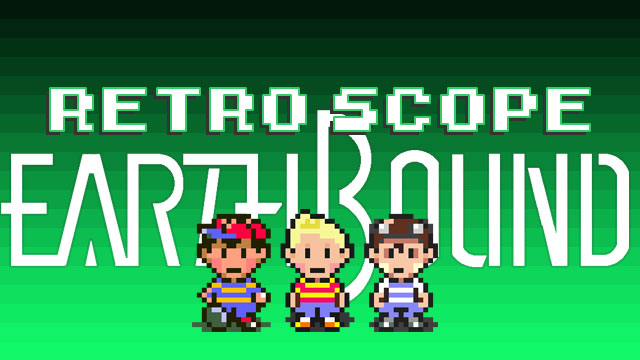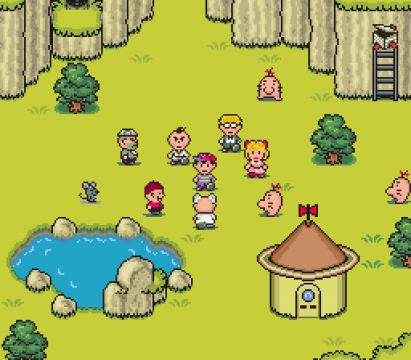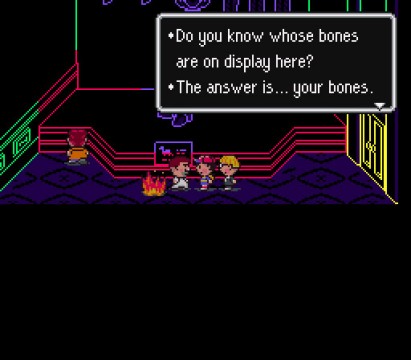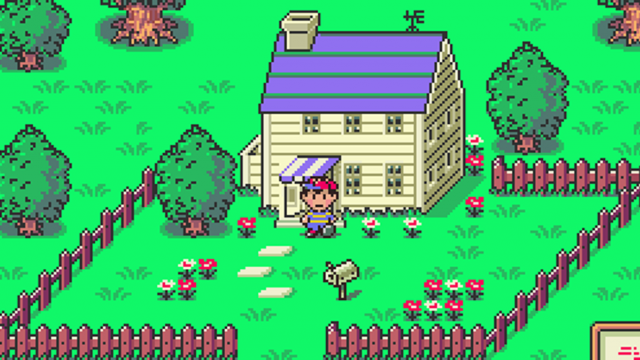
It’s hard to not love a game that comes with scratch ‘n sniff cards. Released in 1995 here in the US, EarthBound is actually the second game in the series Mother (as it’s called in Japan) and was the passion-project of Shigesato Itoi and Nintendo President Satoru Iwata (back in his fledgling days at HAL Laboratory!). Itoi is madly famous in Japan for a variety of things, ranging from writing to video game development to his daily blog (you might have even seen him as a judge on the original Japanese Iron Chef TV series). EarthBound’s pedigree of creators is right up there with classic titles like Chrono Trigger. HAL Laboratory, Ape, and Nintendo united to bring a real masterpiece to the table, but unfortunately it never quite took off as it deserved to.
EarthBound was a very non-traditional RPG. The game revolved around the character Ness and his adventure to end the threat of the alien Giygas. Ness needed to locate eight hidden “sanctuaries” in order to merge his power with that of the Earth’s and use it to defeat Giygas before it could enslave the universe. The battle system featured turn-based action, but with a twist on the typical trappings. Like some very old-school dungeon crawlers, the battle screen featured a static image of the enemy and simple menus displaying various attacks; Ness and his party did not actually appear onscreen. The twist came in the form of EarthBound’s “odometer” health counter. The characters’ HP ticked down as they took damage, but it was possible to stop the progression with healing magic/items or the defeat of an enemy before the meter hit zero. Thus, an element of “speed” was present during battles that added a different factor to consider when planning a battle.

While the non-random battles and battle system were certainly forward thinking, EarthBound is more famous for its refusal to conform to traditional RPG conventions. No swords or lances, no potions, but instead baseball bats and yo-yos, hamburgers and fries. Removing the medieval trappings so often utilized in RPGs, EarthBound instead used food and items synonymous with what one would find in a typical suburb, not a castle. The developers did a great job of finding mundane analogues for shops (drugstores) and inns (hotels) in order to make them fit the world of EarthBound. The game also lampooned RPG currency using a variation of the typical father-son allowance arrangement, with Ness’s dad depositing cash into a checking account as battles were won. There was virtually no aspect of the genre left untouched by EarthBound. Even status ailments got a tweak. Not many game characters can claim to have been afflicted with homesickness!
As far as the structuring of the environment, EarthBound had an interesting interconnected overworld, where the player was able to seamlessly travel between towns as though it were a true, open world. Populating this landscape was a plethora of oddball characters that are hard to forget. Something that was intrinsic to the EarthBound experience was the developers’ quirky humor and satirical depiction of what appeared to be American culture. There was a wealth of social commentary in this game that gave a fascinating look into how the Japanese perceived Western society, or at least a parody or exaggeration of that perception. From police officers whose sole purpose was to put up roadblocks, to books about the necessity of having ATM machines in drugstores to facilitate convenience, the game cast us in an interesting light (one I find pretty spot-on, in some ways).

Helping channel the unique spirit of this game was its stunning visual style. In 1995, the world had already been spoiled by Donkey Kong Country, causing many at the time to criticize the game’s graphics as being ugly or overly simplistic. While today fans have become more accustomed to game developers embracing a diverse array of art directions, the mid-nineties was a much less receptive era, where everyone simply wanted bigger and better. There was an illustrator-like quality to the game’s visuals, propelled by the use of thin outlines and oblique projection to present Ness’s world. I’d be remiss in not pointing out the amazing soundtrack. The variety is mind-boggling, ranging from simple, catchy melodies to haunting, stirring ambient pieces. EarthBound’s presentation was a good 15 years ahead of the curve, boldly choosing a deliberate look and sound that didn’t care about anything other than furthering the vision of its creators.
So what went wrong? A number of things. I believe EarthBound simply showed up at the wrong moment. For one, it was expensive for its time, coming in with a higher price due to its extras and the cost of production/localization. Graphically, it felt inferior to what was being put out on the market at that point, which nonplused some players. Others simply couldn’t get into the semi-psychedelic feel of the game. As much as I love this title, I will openly admit that it’s a bit… weird. Eerie, even. At times, there’s something subtly discomforting about the look and feel of the game and its NPCs, and clearly palpable enough to be polarizing. Many fans are reluctant to embrace something that’s unapologetically peculiar, and EarthBound was as peculiar as it got.

That sounds totally negative, though, and I don’t mean to be. What I’m driving at is that EarthBound relished in its weirdness at times, and players either loved or hated that about the game. I think it’s also worth noting the translation, as it played a big part in how the game was perceived. There are moments when I go back to the game where I can just tell that the writers weren’t totally sure how to convert the original Japanese sentiment into English as well as they might have liked. I’m of the opinion that this added a certain charm to the game that made it special, but others might disagree. Ultimately, there are a number of things that hampered the game’s success, but with EarthBound finally available once more on Wii U’s eShop, hopefully all the negativity is in the past.
So while waiting impatiently for Mother 3 to one day be officially localized by Nintendo, I encourage those who haven’t played EarthBound to familiarize themselves with the greatly under-appreciated classic. Maligned by a more closed-minded media and audience when it first launched, EarthBound was a timeless work that any RPG fan would be wise to give a shot.




 ShareThis
ShareThis






